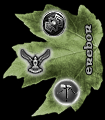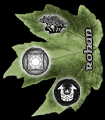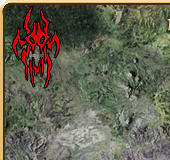|
- The Two Towers Minas Morgul, the Tower of Sorcery, was the stronghold of the Ringwraiths. It was located in the Morgul Vale, a valley in the Mountains of Shadow on the western border of Mordor. It was a walled city of white marble built on a high shelf of rock. Within the walls there were white houses and a tall tower. The walls and the tower had many windows, and the top of the tower revolved slowly back and forth. The Morgul-road ran from Osgiliath on the Anduin through Ithilien to the Morgul Vale and crossed the Mountains of Shadow into Mordor. Near the main gate of Minas Morgul in the city's northern wall, the road spanned a white bridge over the Morgulduin. At the head of the bridge stood hideous carved figures of both human and animal form. Minas Morgul was originally called Minas Ithil, the Tower of the Moon. It was built to keep watch on Mordor when Gondor was founded in 3320 of the Second Age. Isildur, son of Elendil, made his home in Minas Ithil, while Isildur's brother Anarion dwelled across the Anduin in Minas Anor. Ithilien was Isildur's princedom as Anorien was Anarion's. Minas Ithil was a beautiful city and its walls gleamed silver and white with moonlight. In front of his house, Isildur planted a sapling of the White Tree which he had rescued from the Downfall of Numenor, and in the tower was kept one of the palantiri called the Ithil-stone. It was believed that Sauron had perished in the Downfall of Numenor, but his spirit surivived and he returned to Mordor in the same year that Gondor was founded. With the One Ring, he secretly rebuilt his power. In 3429 of the Second Age, Sauron seized Minas Ithil and burned the White Tree, but Isildur escaped with a seedling of the Tree. After Sauron was defeated by the armies of the Last Alliance in 3441 S.A., a watch was kept from Minas Ithil. But in 1636 of the Third Age, the Great Plague came from the east and killed many in Gondor. The guard on Mordor began to relax and people left Minas Ithil. The Ringwraiths returned to Mordor in 1980 to prepare for Sauron's return. The Ringwraiths were the servants of Sauron who had taken the Nine Rings of Men from him long ago. Their leader was the Witch-king of Angmar, the Lord of the Nazgul. In 2000 they laid siege to Minas Ithil and they captured the city in 2002 and took possession of the Ithil-stone. Minas Ithil became the stronghold of the Ringwraiths and it was renamed Minas Morgul, the Tower of Black Sorcery. It was a place of fear and dread and its walls held a sickly light, as if corpse-light surrounded it; and the white marble of Minas Ithil was defiled by the dark rusts of jagged orc-metal. The horror of the valley was so great that men would turn to madness when they approached the city. Across the Anduin, Minas Anor was renamed Minas Tirith, the Tower of Guard, and the Men of Gondor were vigilant against the threat from Minas Morgul. In 2050, King Earnur of Gondor accepted a challenge to fight the Witch-king of Angmar in single combat. He rode with a small company of knights to Minas Morgul and they were never seen again. Earnur was believed to have died in torment in Minas Morgu. He left no heir, and it was from that time that the Stewards began to rule Gondor in absence of a King. Sauron returned secretly to Mordor in 2942 and in 2951 he declared himself openly and began to gather power again. Sauron claimed the Ithil-stone and with it he was later able to ensnare the Wizard Saruman and deceive Denethor, Steward of Gondor, who each had one of the other palantiri. At the time of the War of the Ring, the Witch-king of Angmar and most of the Ringwraiths dwelled in Minas Morgul; two or three other Ringwraiths occupied Dol Guldur in Mirkwood. Numerous Orcs, including Gorbag and Gothmog, the lieutenant of Minas Morgul, were also stationed in Minas Morgul and the Silent Watchers were ever-vigilant. On June 20, 3018, the Witch-king rode forth to lead an assault on Osgiliath, and then he rode north with the Ringwraiths in search of the Hobbit who bore the One Ring. Frodo Baggins, the Ring-bearer, passed Minas Morgul on the way into Mordor with Sam Gamgee and their guide Gollum on March 10, 3019. Frodo felt compelled by the power of the Ring to approach the city where the Witch-king dwelled, but he was stopped by Sam and Gollum at the head of the bridge. They had begun to climb the path leading to Cirith Ungol when a great red flash was sent up from Barad-dur as a signal to launch the assault on Gondor. The Witch-king rode out of the gate at the head of a great army. No greater host had come from Minas Morgul since the War of the Last Alliance, and yet it was only a small part of Sauron's entire force. But the host did not return to Minas Morgul. The Witch-king was vanquished at the Battle of the Pelennor Fields on March 15, and on March 25 the Ring was destroyed and Sauron's realm fell. After the War of the Ring, Sauron's forces abandoned Minas Morgul, but such was the horror of the place that the Army of the West refused to enter it, contenting themselves with burning the fields of corpse-flowers and casting down it's bridge. After his coronation in May of 3019, Aragorn, King Elessar, decreed that Minas Morgul would be utterly destroyed. Although Minas Morgul holds its allegiance with Mordor, it was however, considered a realm apart, free to govern its own affairs and mass it's own armies, all under the malevolent rule of the Witch King. In recent years, the armies of Minas Morgul have had companies of a stronger and bolder breed of Orc march within their ranks. Wherever these creatures are found, it is always there that the soldiers of Gondor are hardest pressed, for their ferocity and bloodlust is far beyond anything encountered in their kind, save perhaps in the half-breed Uruk-hai. It is the armies of Morgul that are called upon to do the bulk of the fighting in the run up to the Battle of the Pelennor Fields and they that drive Gondor's garrison from Osgiliath. The orcs of Morgul are the most organised and disciplined army of all their kind, they are shorter than the Uruks, but as strongly built and fierce. Unlike lesser Orcs, they are clad in tough and serviceable armour, consisting of stout hauberks covered with overlapping iron plates, the work of the smithies of Morgul. As disciplined and organsed thay are, they still carry a variety of weapons to the battlefield, whether it be swords, pikes, maces, bows, crude tridents, or even scythes. The Morgul orcs are mostly distinguished for their crescent-shaped shields and their banner, which contains a moon disfigured by a ghastly face of death, being the emblems of Minas Morgul. |















